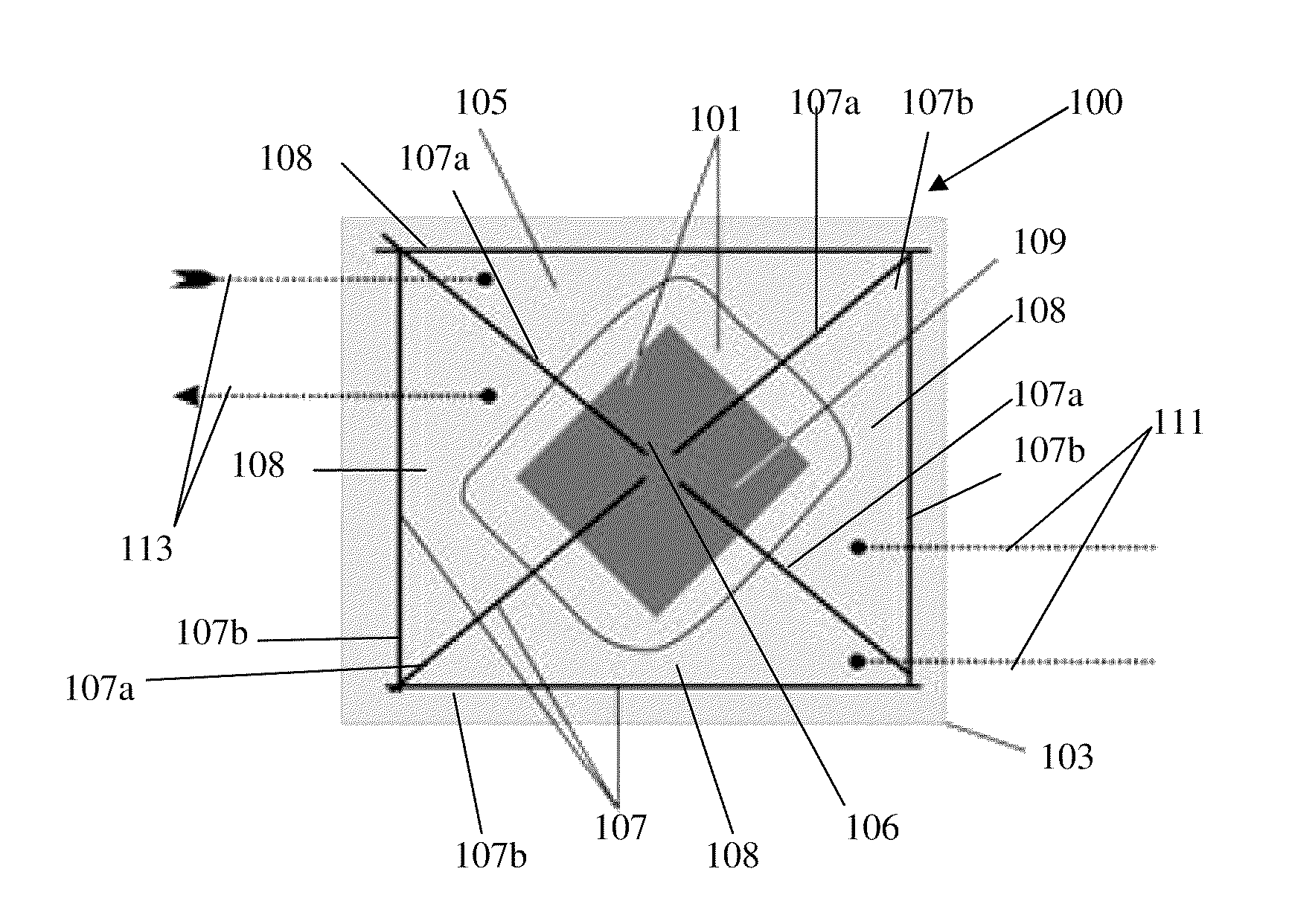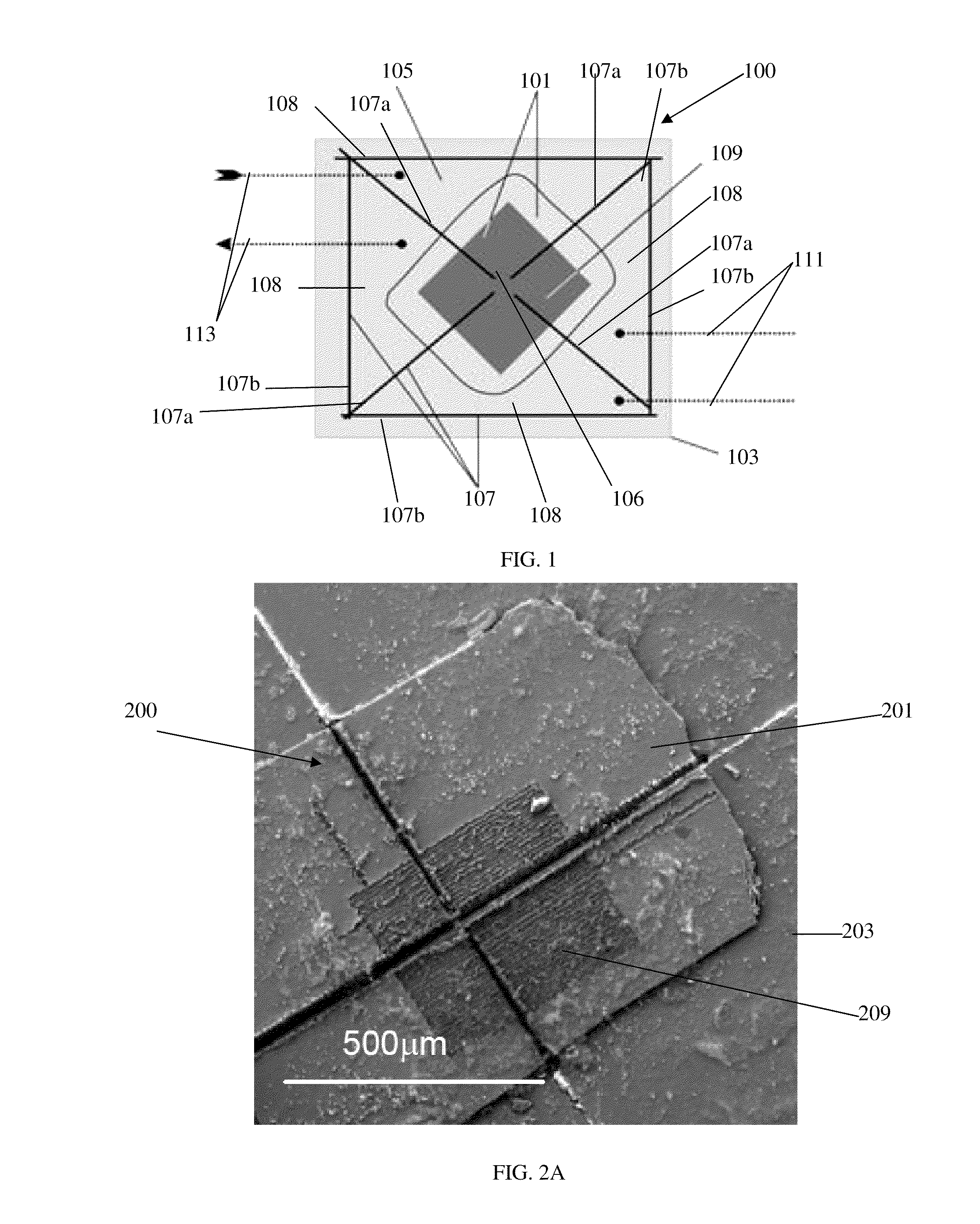Method of making material exhibiting superconductivity characteristics
a technology of superconductivity and material, applied in the direction of inorganic chemistry, ruthenium/rhodium/palladium/osmium/iridium/platinum compounds, chemical instruments and processes, etc., can solve the problems of sr/sub>2/sub>ruo/sub>4/sub> largely unsuccessful
- Summary
- Abstract
- Description
- Claims
- Application Information
AI Technical Summary
Benefits of technology
Problems solved by technology
Method used
Image
Examples
example 1
[0027]Sample preparation. A schematic illustration of a sample 100 including the superconductive material of the present invention, which is manufactured by the process of the present invention, is provide in FIG. 1. All samples 100 of the superconductive material of the present invention were manufactured from a strontium ruthenate crystal (not shown). The strontium ruthenate crystal may be a variety of strontium ruthenate crystals of the Ruddlesden-Popper series generally exhibiting the formula Srn+1RunO(3n+1). Preferably, the nominal composition has n=1 but which may include some presence of some portions of the crystalline lattice where n=2 or n=3, as would be apparent to one skilled in the art. The starting strontium ruthenate crystal may exhibit triplet superconductivity behavior at about 1K. The strontium ruthenate crystal may be grown in accordance with current standard procedures.
[0028]Using the natural anisotropy of such crystals, many strontium ruthenate slices (not shown...
example 2
[0036]Sample composition. X-ray microanalysis provided via Energy Dispersive X-ray (EDX) indicates the average composition to be silver-doped Sr2RuO6±x(x. The results of the X-ray microanalysis are provided in Table 1. According to depth measurements taken via EDX, silver-doped Sr2RuO6±x(xappears to persists to a depth of not more than 2 μm from the upper surface of the original strontium ruthenate crystal. However, as discussed above, estimated depths based on known depths for laser ablation suggest that laser processed region 209 has a depth of about 4-5 microns of the 25 micron strontium ruthenate crystal. At the very least it is clear that the overall depth is on the single micron order, or less than 10 microns and greater than 1 micron. As follows from Table 1, the Sr / Ru ratio in the top layer is about 2, which demonstrates that the laser processing of the present invention includes a material change involving additional oxygen.
[0037]
TABLE 1ElementSEM Microprobes (in at %)Avera...
example 3
[0039]Resistivity measurements. The laser processed regions 209 / 309 of both samples 200 and 300 show a resistivity transition. Multiple resistive transitions were recorded with two-probe and four-probe laboratory setups with the probes made of the same material and directly connected to the non-laser ablated silver layer 105 on the legs 108 defined by grooves 107a. Curves for sample 200 are shown in FIGS. 4A and 4B. Resistive measurements with sample 200 were performed in two different experimental setups. Different contact pads were chosen in FIGS. 4A and 4B. In FIG. 4B, the direction of the current during the measurements was geometrically orthogonal to the current during the measurements of FIG. 4A. Thus, the resistance values of the bridge 106 at 300K are not identical. Further, in FIG. 4A, the resistance was measured at 1 mAmp current in a cryostat. In FIG. 4A, curve 421a represents the resistivity while sample 200 is heating up a first time, curve 421b represents the resistivi...
PUM
| Property | Measurement | Unit |
|---|---|---|
| transition temperature | aaaaa | aaaaa |
| transition temperature | aaaaa | aaaaa |
| temperature superconductor characteristics | aaaaa | aaaaa |
Abstract
Description
Claims
Application Information
 Login to View More
Login to View More - R&D
- Intellectual Property
- Life Sciences
- Materials
- Tech Scout
- Unparalleled Data Quality
- Higher Quality Content
- 60% Fewer Hallucinations
Browse by: Latest US Patents, China's latest patents, Technical Efficacy Thesaurus, Application Domain, Technology Topic, Popular Technical Reports.
© 2025 PatSnap. All rights reserved.Legal|Privacy policy|Modern Slavery Act Transparency Statement|Sitemap|About US| Contact US: help@patsnap.com



